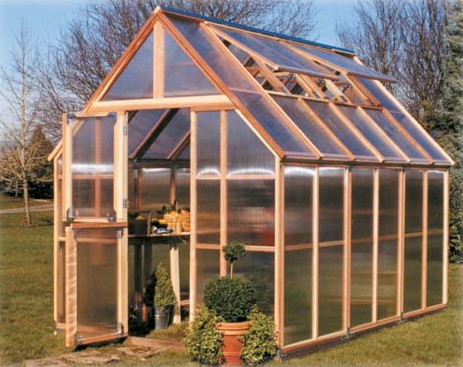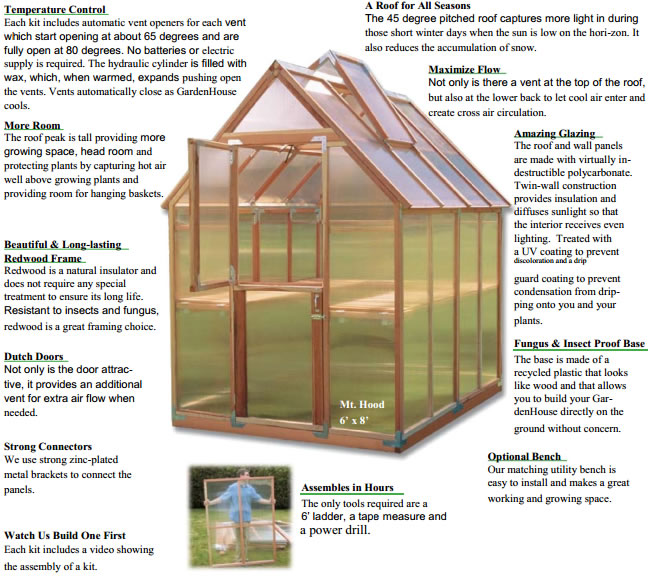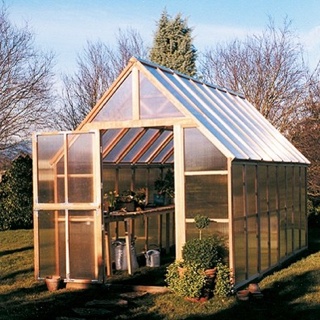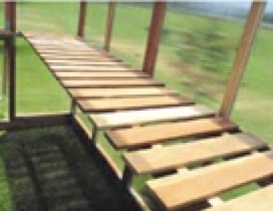-
Home
/
-
Sunshine Greenhouses
Sunshine Greenhouses

At Sunshine GardenHouse, nestled in the Pacific Northwest in Longview, Washington, they take great pride in bringing the joy of year `round gardening to folks throughout North America. They’ve been in business for over 25 years, and building GardenHouses for the last twenty years. Thousands are in backyards across the country, making Sunshine GardenHouse one of the best selling greenhouses in America. Whether driven by the appeal of delicious fresh tomatoes in the dead of winter, a relaxing sanctuary where cell phones are not allowed, or a protected home for their prize orchids, our customers are resounding in one thing—they love their Sunshine Greenhouse Kit.
ABOUT SUNSHINE GREENHOUSES
Sunshine GardenHouse is charming, easy to build and affordable. Our greenhouse kits are built strong, made with natural redwood frames and virtually unbreakable double-wall polycarbonate. Whether it be for ornamental flowers or getting an early start with tender plants started from seed. A good greenhouse can help you garden more effectively and share veggies and flowers from your own greenhouse anytime of the year.
SUNSHINE GREENHOUSE FEATURES
- Door at each end option (no extra charge)
- Accessible door available on Mt. Rainier series
- Made in the USA
- Easy to build greenhouse kit
- 45 degree pitch…no snow load problem
- Roof vents and wall vents with auto openers included
- Over 40 years of gardening expertise
- Wind tested to 85 MPH
- No foundation required
- Dutch doors

SUNSHINE GREENHOUSE FREQUENTLY ASKED QUESTIONS
What are the features and benefits of the Sunshine GardenHouse Kits?
The GardenHouse combines top quality components and functional design.
An Attractive and Durable Redwood Frame, which is naturally resistant to insect and moisture damage. Only second growth redwood is used, preserving old-growth redwood.
Double-Wall Polycarbonate Panels will not crack or shatter, retain heat in the winter, diffuse light for even plant growth, and block 98% of the harmful UV rays. The impact strength of polycarbonate is 30 times greater than acrylic, and 200 times greater than glass.
Assembles Easily and Quickly . The major components of the GardenHouse Kit are panelized for an easy sure fit. And each Kit comes with easy-to-follow instructions, and a convenient product assembly video.
Patented Rigid Tie connectors make the structure rigid and strong.
The GardenHouse was tested by an independent lab, and withstood their maximum wind load capacity of 85 mph with no damage.
The 45 degree roof slope transmits low angle sun in the winter, and reflects high angle sun in summer. This increases heat in the winter and reduces it in the summer. It also provides ample headroom and plant-hanging space.
The steep roof slope sheds show in the winter, and can withstand a snow load of 18 lbs. per square foot.
Automatic solar-powered vent operators on the roof and the base of the GardenHouse contain a paraffin (wax) cylinder that expands when the temperature reaches about 65 degrees F., pushing the vent open to its fully opened position at about 85 degrees F. As the temperature cools and the paraffin contracts, the vent operators springs draw each vent closed. It is also easily detachable for manual operation. A circulating chimney effect is created as cool air is drawn in from the base vent, and warmer air is allowed to escape from the hottest point at the roof ridge.
A convenient Dutch Door Entry provides additional ventilation control and access.
The frame base of the GardenHouse is a durable plastic with the authentic look, color and texture of redwood, but with the consistent properties of plastic, making it resistant to insect and moisture damage.
A foundation is not required. It is only necessary to prepare a flat surface of gravel, wood, cement, or other material as indicated.
Do you offer a video?
We include an assembly video with each Mt. Hood and Mt. Rainier model shipped.
What are the various sizes of GardenHouse Kits?
6′ x 4′ Mt. Hood GardenHouse Contains the same features and height as the 6′x 8′ size; This model is one-half the size of the 6′ x 8′ size.
6′ x 8′ Mt. Hood GardenHouse Is surprisingly spacious due to its 8’6″ height. It comes complete with automatically operated roof and base vents, and a convenient Dutch door entry.
6′x 12′ Mt.Hood GardenHouse Contains the same features and height as the 6′x 8′ size, but includes 50% more space.
8’x8’ Mt. Rainier GardenHouse Our newest size has one roof vent and two back wall vents each with an automatic opener. It is 10 feet tall at the peak.
8′ x 12′ Mt.Rainier GardenHouse Our most popular size GardenHouse has a roof height of 10 feet at the peak. This size affords plenty of space for plants and even outdoor furniture. Expanded ventilation includes two automatic roof ridge vents, and two automatic base vents on the back wall.
8’x16’ Mt. Rainier GardenHouse Our largest size GardenHouse the same features as the 8’x12’ but four feet longer.
Why are the GardenHouses made out of Redwood?
We use redwood for its dimensional stability. Wood acts like a sponge; when it absorbs moisture it swells and when it loses moisture it shrinks. Redwood (shown below on the left) has thinner cell walls which shrink and swell less than other woods, so redwood is less likely to warp, split, cup or check.
Why should a person buy a GardenHouse made out of redwood?
There are many reasons including it’s natural beauty and durability. Redwood heartwood is naturally resistant to decay and insects. Redwood is an excellent choice because it is easy to paint, stain and glue, and no other softwood holds paints, stains and other coatings better than redwood.
Do I need to finish exterior redwood?
Though redwood will perform better than most other woods if left without a finish, it will look better and last longer if a protective finish is applied and maintained.
How do I keep my new redwood GardenHouse looking new and natural?
Clear water repellent finishes containing mildewcides help preserve the natural appearance of redwood siding. They may not, however, prevent the natural color changes associated with the weathering process. Clear water repellents or water repellent preservatives are the most natural types of finishes, but they are also the least durable. They require reapplication every one to two years. These finishes can be used on decks, fences, siding or other exterior projects.
What type of finish is more durable than clear water repellent but still retains a natural appearance?
Transparent and semitransparent stains may last from three to four years. These finishes contain pigments which protect the wood from the degrading effects of solar radiation. The best products contain water repellents, mildewcides and ultraviolet light blockers or absorbers. When selecting a pigmented stain, CRA recommends testing finishes on a small area to be sure the desired color effect is achieved. Transparent stains contain less pigment than semitransparent stains and provide a more natural look. These finishes can be used on decks, fences, siding or other exterior projects.
What finish should I use on the interior of my redwood GardenHouse?
A wide variety of finishes can be used on interior redwood, including the option of using no coating at all. Areas, such as kitchens and baths, which are subject to moisture need the most protective finishes. Alkyd resin or polyurethane sealers and varnishes are appropriate for these areas. Elsewhere, wax finishes, penetrating oils, stains and paints may be used.
Are there any special precautions I should take when painting redwood?
Redwood takes and holds paint better than most woods. It is important, however, to select and correctly apply the right primer. Use oil- or alkyd-based primers or water-born stain-blocking primers on redwood. These primers are available from many paint manufacturers and are formulated especially for redwood, cedar and other wood with a high extractive content. Follow the manufacturer’s recommendations for application closely. The best finishes will not perform if they are applied incorrectly. High quality acrylic latex top coats provide the best durability.
Are there different types of redwood?
There are three redwood species. The Coast Redwood (Sequoia sempervirens) and the Sierra Redwood (Sequoiadendron gigantea) are native to California. The Dawn Redwood (Metasequoia) grows in China. The Coast Redwood is used to make redwood lumber for Sunshine Greenhouses.
Is it necessary to acquire special tools to assemble a Sunshine GardenHouse Kit?
The major components of the GardenHouse Kits are panelized to ensure an easy and sure fit. The panelized sections are joined by screws. A power screwdriver, a 6 foot stepladder, and a tape measure are all that is needed for easy assembly.
How long does it take to assemble a Sunshine GardenHouse Kit?
The ease of assembly is one of the outstanding features of the Sunshine GardenHouse Kit. We offer easy-to-follow assembly instructions with photographs, and an accompanying assembly video to assist our GardenHouse customers. The 6′ x 8′ model takes approximately 4-6 hours to assemble. The 8′x 12′ models takes less than a day for the “non-builder” to complete.
What tools are needed?
The major components of the GardenHouse Kits are panelized to ensure an easy and sure fit. The panelized sections are joined by screws. A power screwdriver, a 6 foot stepladder, an Easy Grip hand vise and a tape measure are all that is needed for easy assembly.
Does the Sunshine GardenHouse require a heater during the cooler months of the year?
The GardenHouse can easily be equipped with a heater for winter use. The heat retention of the double-wall polycarbonate panels is 40% more efficient than single pane glass. As an example, for a 6′x 8′ GardenHouse, when the outside temperature is 10 degrees F, and a 55 degree F temperature is desired inside the GardenHouse, only 6,615 BTU’s per hour of heat would be required. Details are available in the GardenHouse Operation Guide included in each kit.
Do you recommend applying a shade cloth to the GardenHouse during the warmest months of the year?
When the outdoor temperature reaches a consistent daytime reading of 75 degrees, it may be necessary to apply shading to lower the temperature inside the greenhouse. Although temperature is scattered by the ribs between the polycarbonate walls, one may also want to consider the addition of a shade cloth. It is important to remember, however, that shading may slow the growth of some vegetables and flowering plants.
Does the GardenHouse have good ventilation and thorough air circulation?
The roof vent allows air to escape at the hottest point, the roof ridge. Cooler air enters the base vent, creating a chimney effect, and thus circulating cool fresh air throughout the GardenHouse. The convenient Dutch door provides additional ventilation control and easy access. Automatic solar-powered vent operators on the roof and base vents contain a paraffin (wax) cylinder that expands when the temperature reaches 65 degrees F, pushing the vent open to its fully opened position at about 85 degrees F. As it cools, the paraffin contracts, and the operator’s spring draws each vent closed. It is easily detachable for manual operation.
Is the Sunshine GardenHouse able to withstand High Winds without damage?
The GardenHouse has been tested by an independent lab, and has withstood their maximum wind load capacity of 85 miles per hour without damage.
Can the Sunshine GardenHouse withstand a heavy snow load?
The optimum 45 degree roof slope sheds snow in the winter, and can withstand a snow load of 18 pounds per square foot.








